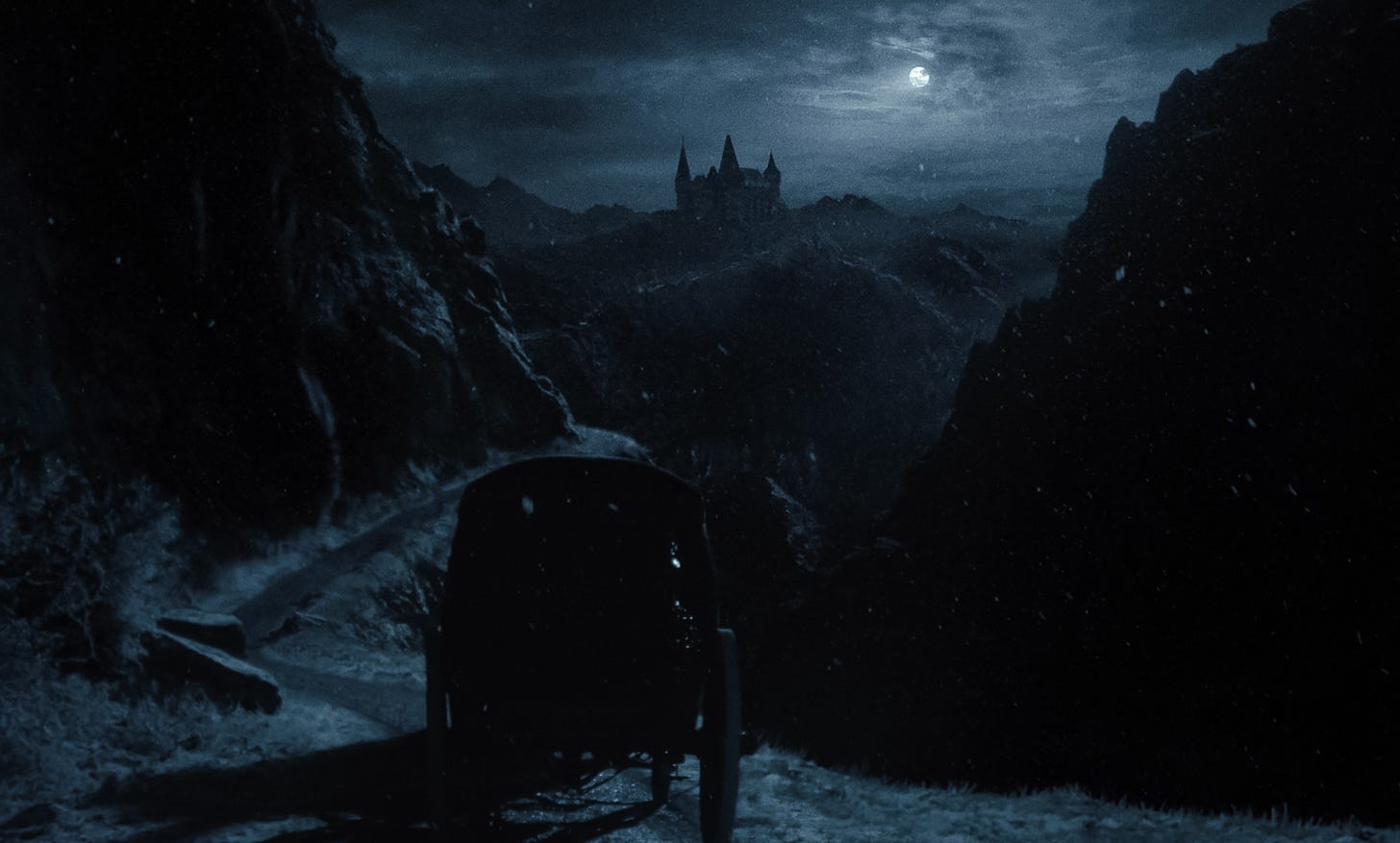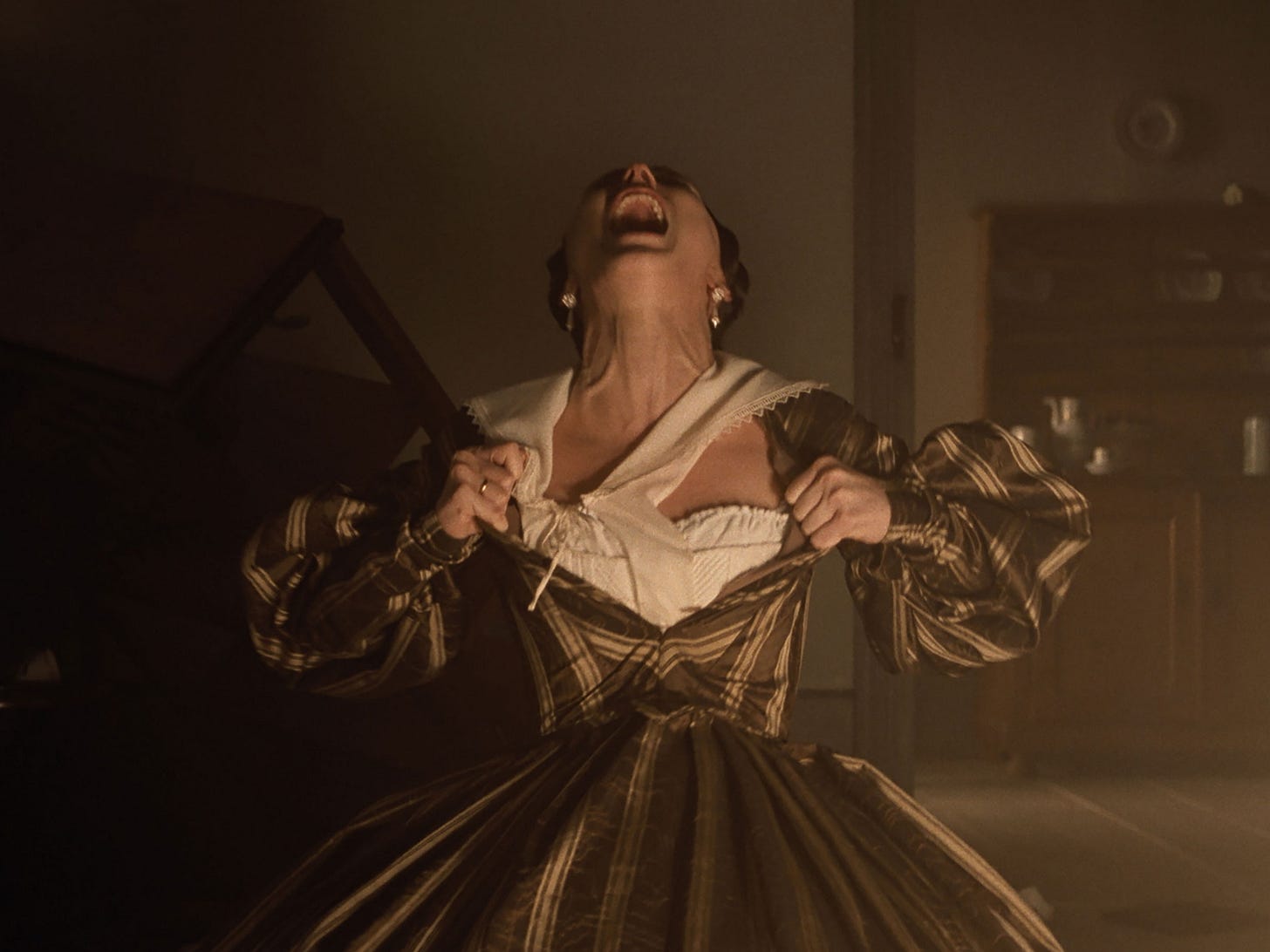A shadowy hand stretches across Wisborg, an ordinary town in 19th century Germany. That’s where Ellen Hutter, the main protagonist of Robert Eggers’ Nosferatu (2024) lives, and that’s where the aforementioned vampire, aka Count Orlok, comes searching for her.
In the course of two hours, we see plenty of shots featuring the iconic hands, the call card from the original Nosferatu movie (F. W. Murnau, 1922). The Count’s hands are illuminated by moonlight and firelight. Their shadow slithers along the walls of the nocturnally lit townhouse. When Nosferatu is all but hidden in darkness, it is his hands that are being shown. That’s a ridiculous abundance of hands. And then there’s his voice. Guttural, wheezing, cryptic. The voice is a stunning new addition to the image of Count Orlok. Bill Skarsgård, who is playing the Count, speaks Dacian, the ancient language, now extinct, which adds even more to the otherworldliness of the vampire.
Orlok’s face is savage, his body is rotting, gruesome. Not immaculately preserved in the least. Ragged military attire of 16th century Hungary barely gives him a modicum of propriety. But the Count doesn’t try to impress anyone with his style or manners. This vampire is far removed from the image of pale sensuality and polished danger that we’ve got used to. He is an embodiment of pure instinct, brutally simple. He is, in his own words, an Appetite.
Vampire is a perfect metaphor for unquenchable hunger, and he casts his shadow on other characters of the film too, as every one of them is filled with their own worldly desires.
Knock, the owner of a brokerage firm, seeks to empower himself by aligning with the forces of evil. With the help of occult rituals, he seeks out Nosferatu and invites him to leave his castle in Transylvania for a ruined manor in Wisborg. Nosferatu obliges him, and with pleasure. Because in this modern country he will be safe from ‘superstitions’ of his rural homeland. Civilised, rational inhabitants of Wisborg won’t believe in his existence and wouldn’t know how to protect themselves from his appetite (or their own, if we follow through with the metaphor). To them, his arrival looks like the arrival of a plague. And plague in that enlightened age is just a plague, an insatiable Yersinia pestis, brought to the city by the rats, who accompany the Count and constantly gnaw on things (and bodies).
Then there’s Friedrich, Ellen’s brother and a wealthy shipbuilder. His only concern is his business and his family: two little daughters and Anna, his wife. Of Anna he cannot have enough, and, as we discover in the first minutes of the movie, she is pregnant, once again.
Thomas, Ellen’s husband, craves status and money that comes with it. On an assignment from Knock, he ventures into Transylvania to present Orlok with the paperwork. His arrival in the Carpathians elicits laughter from the Roma people stationed by the local inn. Among them, who are easy and knowing, Thomas looks ridiculously lost and naïve. His craving for gold (and bourgeois comforts that come with it) stands in opposition to the Roma’s freewheeling non-attachment to goods. (Oh well, they steal his horse in the morning.)
Ellen, albeit deeply in love with Thomas, is perplexed, then angered with his more-more-more mentality. However, she too yearns for something. Her yearning, unlike everybody else’s in the movie, is laced with shame. There’s a fatal flaw in Ellen, which is her loneliness, a dark residue of an unhappy childhood — mother dead at a young age, father distant. Once, as a girl, she called out into the darkness of the night to anyone who would hear her, so that they would come and comfort her. An angel, she hoped. But it was Nosferatu, a demon, who answered. He started visiting Ellen, visible only to her, but no less invasive for his incorporeality. We are shown snatches of Ellen’s moaning and thrusting of hips. Local doctors diagnose her fits as melancholia, or hysteria. Freud would have called it repressed memories of early sexual abuse.
Later, Professor Eberhart, who is an odd one himself, dabbling in alchemy and occultism, offers another theory for Ellen’s fits: she is naturally receptive to the world of spirits and in another time would have become a priestess.
Robert Eggers has already touched on the topic of femaleness and power before, in The Witch (2015), and were Ellen to live in Puritan New England, she would have been, surely, called a witch. Being in possession of that strange power makes her different, inexplicable, dangerous. She is the Other, not able to blend in. Although she is yearning for peaceful ordinariness, she can’t make sense of her society and its attitudes towards those who are vulnerable and different. She doesn’t see the point of accumulating objects. Ironically, she chooses to die defending the world that she cannot fully accept and become a part of. She comes to her final, fatal decision when Friedrich’s perfect family, that ray of golden sunshine, is completely swallowed by darkness.
By the end of the film, in a very puritanical turn, all participants of this drama pay for indulging their desires. Knock goes mad and ‘is reduced to being a prince of rats,’ tearing rodents and pigeons apart with his teeth, blood spraying his once-white shirt. Thomas loses his wife and almost loses his life. Friedrich, who wouldn’t believe the existence of a demon that has been abusing his sister, loses everything. Ellen martyrs herself. The story is more cautionary rather than uplifting.
Looking at the stylistics of Nosferatu, the movie is chock full of Gothic tropes. There are grim, misty mountains, isolation, spooky sounds, a castle and a ruined manor, doors opening without anyone touching them, crypts, coffins, occult practices, a monastery, demonic possession, exorcism, revenge, blood, nightmares, separated lovers, carnality, melancholy, and body horror. Many of them can be found in the original Nosferatu. What differentiates Eggers’ iteration from the Murnau’s though, is the film’s focus on Ellen. There is movement towards the psychological, to the point of the movie becoming an existentialist drama about alienation and struggle of the Other, where the Other is not the vampire, but his victim. It is Ellen’s loneliness, strangeness, abuse and the following inner struggle that become the subject of the horror. She is at peace only in the very end, when she discards the corset of social expectations and submits completely to her strange power, and, by acknowledging it, makes the darkness vanish.
In The Gothic, Nick Groom talks about a shift from outward to inward, which happened in Gothic literature when American writers adapted the Gothic tradition of the Old World to their own reality. Since the cultural conditions of the New World didn’t match those of the Old, there was a movement towards psychological style. In addition to that, sexual violence became one of its main themes.
When Murnau was making his Nosferatu, he changed Bram Stoker’s Dracula in a way that touched on the needs, tastes, and fears of his time and place. His film later was argued to be anti-semitist in its depiction of Orlok.
When Eggers transplants the German Nosferatu onto American cultural soil, he, similarly to the American authors, goes inward. He preserves the outward structure of the original, but plays with it until the focus shifts from the monster to his victim, Ellen, who is given a chance to avenge herself, albeit getting killed in the process. In this sense, Nosferatu is a very American Gothic story.
I’ve expected the shift towards the psychological to make the film more intimate and relatable, but, strangely, it is not so. The picture is beautiful, the actors’ performance is masterful, the story is superbly Gothic, but when I ask myself if I am haunted by it, the answer is — not so much.
In its attention to detail, the movie borders on historical, in its focus on the female and the unconscious, it resembles the movies that have already been made on the theme of female sexual repression, which makes it look like a historical drama spinning a rather tired yarn. Despite the abundance of possible interpretations, like criticism of imperialism/capitalism/patriarchy, Nosferatu has nothing new to say. A lot is going on on the screen, but the story feels empty. It is as if the body were revived, but the insides were somewhat withered, like that of a vampire.







